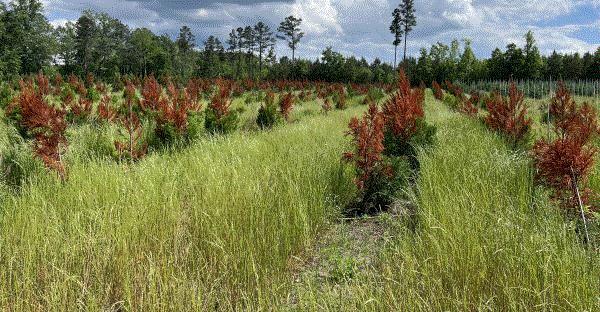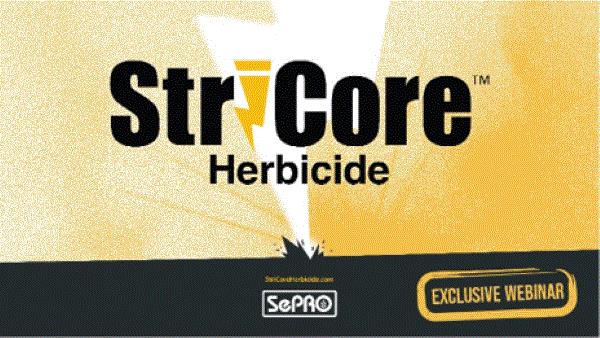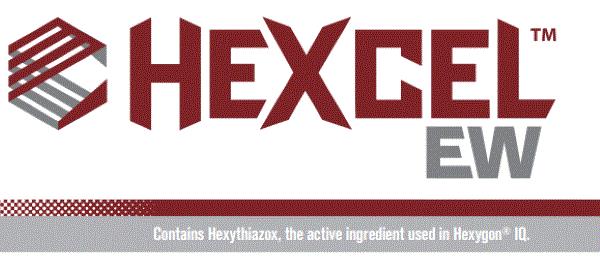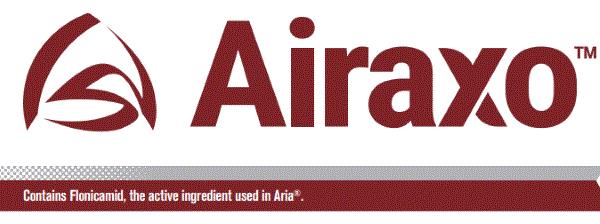What the ... ?
Here is something I have never seen before. I was at a nursery in North Carolina in May and saw a field of brown-topped cryptomerias. The entire field was affected. Really crazy and shocking stuff. Guess these (probably two- or three-year-old) cryptomerias are done for. The trees ain’t dead but they won’t look right after recovery.
So, I’ll ask you the same question I asked the grower, “What in the world is going on here??!!”

SePRO Introduced StriCore Herbicide at Cultivate
I was glad to see many of you at Cultivate last week. The show attendance was great, but the best parts were the conversations we had at the booths and along the alleys. It’s great to catch up.
Many folks asked me how it feels one year after joining private industry. Tell you what, there’s never a dull moment because I have to wear many hats. I must change from an entomologist to a pathologist and then to a horticulturist at a moment’s notice.
One hat I had to wear at Cultivate this year is a weed scientist’s hat. My major task was to introduce StriCore, a brand-new preemergence herbicide from SePRO, to the ornamental market. StriCore contains pethoxamid, which is a new Group 15 active ingredient. Pethoxamid represents the first new preemergence herbicide active ingredient since … I’ll say at least 10 years ago. Now, when I say “new,” I really mean it. Pethoxamid is only available to the turf and ornamental market; y’all won’t find an agricultural formulation/product of this herbicide. It’s somewhat of a reverse in fortune, since we usually get a new product after the agricultural sector has used it for several years.
In addition to turf uses (golf courses, lawns, sod farms, roadsides, etc.), StriCore is registered for use in field-grown and container nurseries for directed application to bare-ground, which includes bare-ground between and around the base of plants and pots, roadways, gravel pads, etc. Target weeds are annual grasses (such as crabgrass and annual bluegrass) and small-seeded broadleaf weeds (such as oxalis and hairy bittercress). StriCore also suppresses nutsedges; I’ve seen good suppression of yellow nutsedge in an on-going trial.
Based on data generated by researchers and growers around the country and our internal research team, I recommend StriCore as a tank-mix partner in your existing preemergence program to achieve the greatest spectrum of control and residual longevity. Effective tank-mix partners include indaziflam (Marengo or Specticle) and flumioxazin (SureGuard and generics). I think StriCore can fit in any existing preemergence herbicide program to help reduce the risk of herbicide resistance development. Let me know if I can help develop an herbicide program that can deal with the weed species on hand and reduce resistance risk and cost.

The application rate is 16 to 48 fl. oz. per acre, with a yearly limit of 48 fl. oz. per year. I recommend tank mixing StriCore at 48 fl. oz. per acre with another preemergence at half rate to achieve the greatest efficacy and residual longevity. REI (restricted entry interval) is 12 hours, and PPE (personal protective equipment) are coveralls over long-sleeved shirt and pants, protective eyewear, gloves, and shoes plus socks.
StriCore isn’t registered for over-the-top application at this time. I’m researching crop safety and efficacy to support over-the-top application as I write. So far, I have seen high tolerance of many commonly grown species, especially conifers. Hopefully, I’ll have enough data to register StriCore for over-the-top application soon.
Go HERE to find more information on StriCore and sign up for StriCore Insider (which is a channel developed to communicate the latest research and news on StriCore). Also, go HERE to register for a webinar scheduled for 11 a.m. Eastern on July 31 when I’ll chat with you about how StriCore works, how effective it is, how to fit it into your weed management program, etc.

Atticus Introduced New Products
Atticus announced the addition of three new products to its EcoCore Greenhouse and Nursery portfolio this week.
Berati 10 XC contains the plant growth regulator paclobutrazol and is registered for use on commercially grown ornamental plants in nurseries and greenhouses. Berati 10 XC is formulated at 4% paclobutrazol, which is 10 times more concentrated than Atticus’s own Berati, as well as the more well known Bonzai and Paclo. Like other paclobutrazol products, Berati 10 XC can be applied as foliar spray or drench. REI is 12 hours, and PPE includes long-sleeved shirt and pants, protective eyewear, gloves, and shoes plus socks. Go HERE for more information on Berati 10 XC.

Hexcel EW contains hexythiazox (IRAC 10A), the same active ingredient of Hexygon IQ. Hexythiazox is a mite growth regulator, which makes eggs unviable and kills immature mites. It’s important to remember that hexythiazox only works on species in the spider mite family (Tetranychidae). Hexcel EW is registered for use on ornamental plants, Christmas trees, turfgrasses, and certain fruit and vegetable crops. Hexcel EW has an emulsion-in-water formulation, which is different from the dry flowable formulation of Atticus’s own Hexcel 50 DF. REI is 12 hours, and PPE includes coveralls over long-sleeved shirt and pants, chemical resistant gloves, and shoes plus socks. Go HERE for more information on Hexcel EW.

Airaxo contains flonicamid (IRAC 29), which is the active ingredient of Aria and (part of) Pradia. Flonicamid is a chordotonal organ modulator, and I find it quite effective against sucking insects (aphids, whiteflies, etc.) and thrips. Airaxo is registered for use on ornamental plants in nurseries and greenhouses. REI is 12 hours, and PPE includes coveralls over long-sleeved shirt, protective eyewear, chemical resistant gloves, and shoes plus socks. Go HERE for more information on Airaxo.


FMC to Sell Global Specialty Solutions to Envu
FMC Corporation announced last week that it has signed an agreement to sell its Global Specialty Solutions (GSS) business to Envu. The selling price is tentatively set at $350 million. The GSS portfolio includes products for the turf, ornamental and pest control industry, basically anything that’s not agriculture related. “With this divestment, FMC can focus solely on its core business,” said FMC’s CEO Pierre Brondeau.

The transaction is expected to close by the end of 2024. It’s too early to say with any certainty what will happen to Envu’s portfolio, but I expect Envu’s turf and ornamental portfolio to expand after the inclusion of some products acquired from FMC.
Go HERE for the announcement.
Answer to “What the … ?”
We are finally getting more rain on the eastern coastal plains of the Carolinas. Obviously, the dry spell in May and June hadn’t been kind to many plants grown in field nurseries that weren’t irrigated.
I think the cryptomerias in this case were casualties of this stressful environment. Now, the dry spell may not be the issue that started the cascade of events, but it’s certainly not lessening the blow or helping with recovery. Neither the grower nor I know what the actual cause of the decline was. It might have been winter damage, excessive heat, fertility issue or even root girdling. Let me know if this also happened to your cryptomerias, what’s the cause, and what you did to solve the problem in the next crop.
Another clue that tells me that the cause is something abiotic is the relatively even and widespread distribution of similar symptoms. Go HERE for a previous issue of this newsletter where I talked about how to diagnose abiotic problems.
See y'all later!

JC Chong
Technical Development Manager at SePRO
Adjunct Professor at Clemson University
This e-mail received by 27,847 subscribers like you!
If you're interested in advertising on PestTalks contact Kim Brown ASAP!